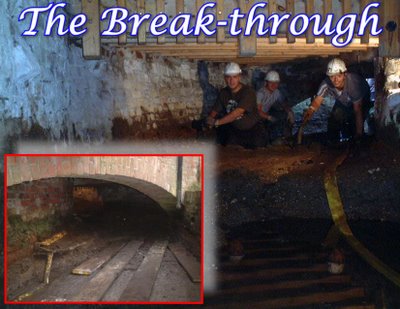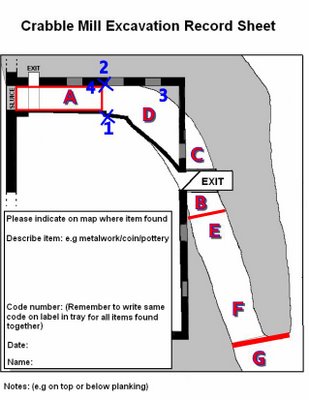Monday, October 30, 2006
Tunnelling

Message to Keith Parfitt:
We’re now getting close to uncovering the planking of the whole tailrace and it should be done either later tomorrow or by later this week. They’ve done amazing work, so far!
Current thoughts are that it’s an old Trout-breeding farm which was set into the tailrace of an older mill structure. If so, this begs the questions “how old is the trout farm” and “how far do we go down in excavating further”?
I’ve also found some small evidence of other structure set in the bank (just outside the Mill) which we’ll put a square around and mark for a trench later.
Excavation Plan

Message to Phil Eyden, Archaeologist:
We’ve had a gang here working today and you would not believe the extraordinary progress they’ve made … and taken more pics. We’ve got one person in tomorrow, but the next gang will be in Monday.
I’ve asked Clive Alexander (Conservation Officer, DDC) for his views. I’ve written to our Hydro guys and funders to get their views. We will still be time-driven even if we get some leniency. I think this blog is the best way of keeping everyone informed.
Water channel in old tailrace

Message to Phil, HydroGeneration Ltd:
Thanks for the reply. I’m glad to hear some of these funding agencies can be flexible if presented with real, legitimate cases for extension.
I hope to talk to Phil Jackson tomorrow and also your Tim re measurements, depths and methodologies (apparently you’re on-site elsewhere at the moment – empire building, I trust?).
We’ve done more excavation today in the tailrace outside the Mill, working inwards. It’s VERY interesting! We’ve uncovered an extended deck base set on timbers which, though extremely fragile, is largely in-tact. We now have to carry on with this until the whole lot is uncovered for the archaeologists to take a view. Obviously, these findings have little to do with this version of Crabble Mill but one of it’s predecessors, probably not ancient but definitely pre-dating our current records. Therefore we are obliged to see this through and record it, it’s a one-off opportunity!!
The submerged ‘wooden deck/base’ in the pit (inside the building) appears, at first sight, to be significantly LOWER than the submerged ‘wooden deck/base’ in the exterior tailrace. This, obviously is contrary to what one would expect. We would be anticipating water to be flowing downhill not uphill!!!
I think it’s highly unlikely we’ll be able to put a concrete base for the turbines in the pit now and will have to probably work out some other method of fixing, perhaps a framework anchored into the side walls with anti-vibration pads so that the turbines are suspended (in water) at the same level?? My other practical issue is whether or not the external tailrace will achieve your required depth for water discharge? Other issues are financial …. i.e. are any variances alterations absorbed or additional? Also, our Educational/Interpretation panels as off-set costs (previously discussed)? I need dialogue and some advice, please.
I’d like to take some more measurements, photos and may be do some more excavation to give you a fuller, more complete picture so that there are no more hidden secrets left to be revealed, prior to your next visit.
Thursday, October 26, 2006
Cutting the grills and concrete

Message to Keith Parfitt:
Many thanks for the ‘rapid response’ and also for sharing our enthusiasm. To me, no matter what age our findings turn out to be, it’s still very exciting and we stand to learn a lot more about Crabble Mill(s) …. or whatever they are.
Firstly, we’ve now managed to cut-out the old metal grill and hammer-out the concrete lintel in the tailrace where it externalises from the building. Fascinating! We’ve found some more wood at a much higher level (though not uncovered it yet), about 400mm higher (my simplistic physics tells me that water trends down hill, not upwards!!!)
Secondly, another joist (with fixings) which spans the tailrace watercourse, but this is well outside the building and is closer to the surface. I’ve taken some measurements. One of the interesting things here is that whilst it’s probably only just beneath the mean water level, it is has a slate facing on the upstream side which would indicate to me some form of small intentional water retention ‘device’. Not much of this is making very much sense at the moment. Will find out more tomorrow ……
First Press Article - Dover Express

Leading archaeologists were called to one of Dover's busiest tourist attractions after an exciting discovery was made beneath its floor.
Volunteers at Crabble Corn Mill in Lower Road had been digging in the building to install equipment allowing the site to run off power from water in the River Dour.
But as they went deeper into the wheel pit they found something unexpected underneath - an ancient wooden floor.
Neil Anthony, founder of the Crabble Corn Mill Trust, said "it's very, very exciting. Whatever it is, it predates our mill by centuries."
Records show there has been a mill in River since at least 1227. It is believed a much older Roman construction once stood on the site and archaeologists have been trying for years to find evidence of it. The mill as it stands today was erected in 1812.
Work in the pit stopped immediately whilst Keith Parfitt of the Kent Archaeological Trust was called in to survey the find. Mr Parfitt, responsible for finding Dover's famous Bronze Age Boat beneath Townwall Street, told trustees he thought the discovery was important.
The site is now being prepared for a full excavation.
Mr Anthony said "we have an aweful lot of work to do."
We have about 80-100ft of riverbed to dam-off and dig to half a metre or a metre deep. Then we call in the archaeology team."
Last year the site featured a dig in its grounds which found a clay floor believed to be a medieval building. It is hoped that area may be opened up again in March, with its contents compared to the new findings.
26 October 2006

